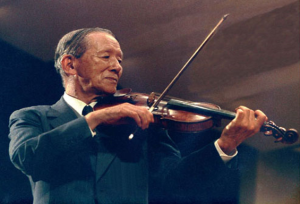Shinichi Suzuki
 Shinichi Suzuki was born in 1898 in Nagoya, Japan. His parents owned a violin factory, though he himself did not receive musical training. At one point he heard a recording of Mischa Elman playing the violin, and was so moved by its beauty he set out to teach himself to do the same thing, learning to play the violin by listening to and mimicking the sounds heard.
Shinichi Suzuki was born in 1898 in Nagoya, Japan. His parents owned a violin factory, though he himself did not receive musical training. At one point he heard a recording of Mischa Elman playing the violin, and was so moved by its beauty he set out to teach himself to do the same thing, learning to play the violin by listening to and mimicking the sounds heard.
In Germany
As a young man, Suzuki traveled to Germany, where he received formal training from Karl Klinger. After Dr. Suzuki’s return to Japan, hardships and difficulties stemming from World War II fostered in him a desire to positively impact the lives of children. He felt that teaching children to hear, appreciate, and create beautiful music would nurture within them beautiful hearts. His goal was not to bring up concert violinists and performers, but to develop people of high character by fostering respect, hard work, discipline, and responsibility; teaching children to make music with skill and joy, and ultimately to make the world a more peaceful place. To this end, he used the concept of “Character first, then ability” recognizing that the development of musical talent was secondary to the development of moral fiber.
Mother Tongue Approach
Dr. Suzuki had noticed in Germany that despite his own difficulties learning the language as an adult, the German children all spoke it fluently with ease. And observing that all children in all countries learn to speak naturally by hearing and repeating sounds and receiving enthusiastic encouragement, he applied this “Mother Tongue” principle to the teaching of music.
Talent Education Research Institute
Dr. Suzuki created the Matsumoto Music School and the Talent Education Research Institute in Japan. In the 1960s a tour group of Japanese Suzuki students inspired a music education movement in the United States, where there are now thousands of students studying violin, viola, cello, bass, guitar, harp, piano, flute, recorder, voice and trumpet. The Suzuki Talent EducationMethod is now used in over 38 countries, with more than 400,000 students worldwide.